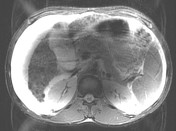Dielectric effect artifact
Updates to Case Attributes
This is not a problem with windowing and leveling, but the dielectric effect artefactartifact, an inherent limitation of higher field MRI systems.
As the field strength of an MRI unit increases, its radiofrequency (RF) wavelength in tissue decreases:
- 1.5 T: 52 cm
- 3.0 T: 26 cm
- 7.0 T: 11 cm
As the wavelength decreases to the point where it approximates the abdominal diameter (at 3.0 T, ~26 cm), the constructive constructive and destructive interference patterns may result, and in body MRI imaging, this most often results in a darkening/shading of the central portion of the image.
To improve the artefactartifact, the easiest solution is often to just switch the patient to a lower field system (e.g. 1.5 T) .
-<p>This is not a problem with windowing and leveling, but the dielectric effect artefact, an inherent limitation of higher field MRI systems. </p><p>As the field strength of an MRI unit increases, its radiofrequency (RF) wavelength in tissue decreases:</p><ul>- +<p>This is not a problem with windowing and leveling, but the <strong>dielectric effect artifact</strong>, an inherent limitation of higher field MRI systems. </p><p>As the field strength of an MRI unit increases, its radiofrequency (RF) wavelength in tissue decreases:</p><ul>
-</ul><p>As the wavelength decreases to the point where it approximates the abdominal diameter (at 3.0 T, ~26 cm), the constructive and destructive interference patterns may result, and in body MRI imaging, this most often results in a darkening/shading of the central portion of the image.</p><p>To improve the artefact, the easiest solution is often to just switch the patient to a lower field system (e.g. 1.5 T) .</p>- +</ul><p>As the wavelength decreases to the point where it approximates the abdominal diameter (at 3.0 T, ~26 cm), constructive and destructive interference patterns may result, and in body MRI imaging, this most often results in a darkening/shading of the central portion of the image.</p><p>To improve the artifact, the easiest solution is often to just switch the patient to a lower field system (e.g. 1.5 T) .</p>
Updates to Study Attributes
Image MRI (T2 fat sat) ( update )

Image MRI (T2) ( update )








 Unable to process the form. Check for errors and try again.
Unable to process the form. Check for errors and try again.